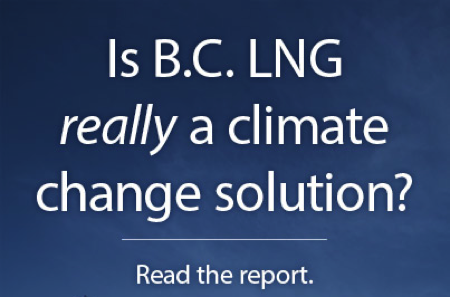The B.C. Legislature is currently debating Bill 2 that is intended to limit carbon pollution from liquefied natural gas (LNG) terminals. The basic approach of the bill is to set a carbon pollution limit (expressed in tonnes of carbon pollution per tonne of LNG produced) for LNG terminals. Project operators could either meet that target by reducing their anticipated carbon footprint, or they could choose to invest in offsets or a technology fund instead.
The strength of the bill is that it’s designed to build on the province’s carbon tax. If the technology fund price is high enough and the offsets are high quality, this new system will result in less carbon pollution from LNG development.
However, the bill also has significant flaws that will limit this potential benefit and could even weaken B.C.’s climate policies in a worst-case scenario. Below, I’ve highlighted three of the most important weaknesses and offered some ideas on how to address them.
Eliminate the potential for carbon tax exemptions
As drafted, the bill would give Cabinet the ability to exempt LNG terminals from the carbon tax. If this exemption were activated through regulation, the net result would be weaker climate policy. That’s because the incentive to reduce carbon pollution from the new bill will be the $25 per tonne technology fund price (or less if offsets are cheaper), which is lower than the $30 per tonne incentive provided by the carbon tax.
But, if the new bill and the carbon tax work together, the incentive to reduce carbon pollution would be as high as $55 per tonne.
The potential exemption isn’t needed. In her defense of the bill, Environment Minister Polak spoke clearly about the importance of B.C.’s carbon tax and the government’s commitment to the policy. The government is also counting on carbon tax revenue from LNG terminals, according to the supporting materials for its LNG tax legislation (see slide 12 here).
This weakness could easily be fixed by removing the potential exemption, introduced in Section 56.
Regulate carbon pollution from shale gas and LNG pipelines
A prominent point of criticism of Bill 2 has been that the carbon pollution from upstream sources such as shale gas development and LNG pipelines are not included in its scope. Based on our analysis, these upstream sources could account for about 70 per cent of wellhead-to-waterline carbon pollution from LNG.
The NDP and Green Party consistently criticized the government for this policy gap. To her credit, the Environment Minister agreed and spoke of the need to do more:
“We know the real challenge is with emissions that are coming from the upstream. Huge challenges, but also huge opportunities.”
Part of that challenge will be implementing policies that lead to changes like reduced methane leaks, more renewable energy and more energy efficient processes.
One option is that Bill 2 could be modified to include specific upstream sources. For example, pipeline compressors and gas processing plants are large point sources of carbon pollution that could also be regulated by the bill. Work would need to be done to figure out appropriate limits, but there’s no reason why it couldn’t be accomplished quickly. Other options include strengthening the carbon tax or improving Oil and Gas Commission regulations.
Design LNG policies so that carbon pollution levels drop over time
In its current form Bill 2 will not require carbon pollution levels from LNG terminals (or the accompanying upstream development) to drop over time. This is a problem. As confirmed by the province’s 2014 climate progress report, policies must get stronger over time if targets are going to be met. The province has achieved some good success since it initiated its Climate Action Plan in 2007, but that success will only be sustained if policies continue to improve.
As with efforts to address upstream carbon pollution, the government has lots of policy options at its disposal to require ongoing improvements in performance. A simple option would be to continue increasing the carbon tax. Bill 2 could also be used if carbon pollution limits and technology fund prices were both strengthened over time.
For the carbon pollution limits, a schedule of increasing stringency could be accommodated within the existing legislation and could even be aligned with the province’s 2020 and 2050 climate targets. For proposed LNG terminals, this would encourage proponents to look at a full range of design options, including those that exceed the current target.
Similarly, a schedule of increases for the technology fund price is already made possible in the bill (see Section 48.2). An increasing technology fund price would provide a stronger incentive for LNG proponents to reduce their carbon pollution and increase the amount money available in the fund. To date, the Environment Minister has only confirmed an initial price for the fund ($25 per tonne). There’s nothing stopping the province from leading a discussion on what that price should be in 2020 and beyond.
What happens next?
Of the three ideas in this blog, removing the potential carbon tax exemption from Bill 2 would be the easiest to act on and would send a clear signal that Bill 2 is intended to complement the carbon tax for the foreseeable future.
Following through on the commitment to address upstream carbon pollution will take some work, but that work can and should happen quickly. Whether its Bill 2, the carbon tax or something else, the province needs to decide quickly on the policies it is going to use.
Ensuring that carbon pollution from LNG declines over time first requires a commitment from the government that increasing the stringency of the policy is a priority. With a commitment in place, proponents will know that the performance bar is going to keep raising between now and 2050. As with upstream carbon pollution, government could accomplish this using Bill 2, the carbon tax or other tools.
Other challenges will arise, but getting to work on this list would be a good start.









